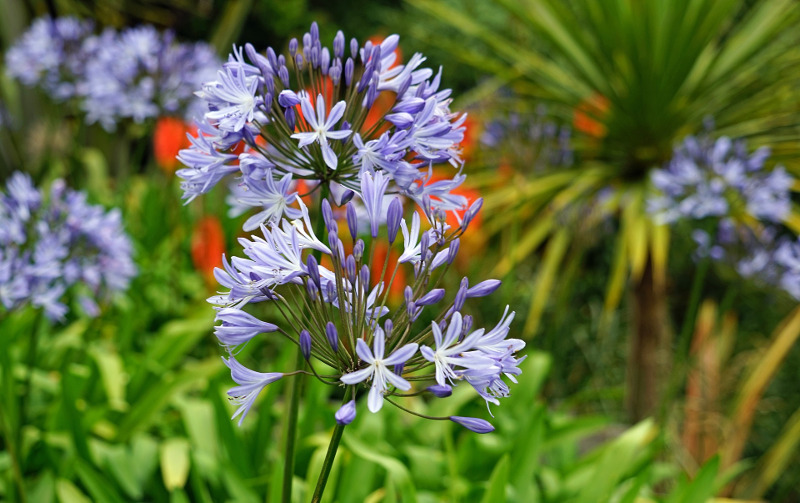Seasonal Agapanthus Care: Preparing for Winter and Summer
Seasonal Agapanthus Care: Preparing for Winter and Summer
Blog Article
Grasping the Art of Agapanthus Treatment: Vital Steps for Healthy And Balanced Growth and Vibrant Blossoms
In the realm of horticulture, the farming of agapanthus stands as a fulfilling undertaking for those that look for to nurture these stylish blooming plants. From choosing the ideal variety to understanding pruning techniques, the trip towards growing growing agapanthus plants is diverse and holds the vital to opening the complete capacity of these herb gems.

Picking the Right Agapanthus Selection

When picking the ideal Agapanthus variety for your yard, think about factors such as climate suitability, blossom color, and development routine. Additionally, think about the environment in your region to ensure the Agapanthus variety you select can grow in your certain conditions. Recognizing the development routine of different Agapanthus ranges is crucial for correct placement within your yard.
Perfect Planting Problems
Considering the optimal ecological demands is important for successful Agapanthus growing. Agapanthus grows in well-draining soil with a somewhat acidic to neutral pH degree. When growing, choose a place that receives full sunlight to partial color. In hotter environments, offering some mid-day color can avoid scorching of the fallen leaves. Agapanthus plants are delicate to cold temperature levels and must be shielded from frost during winter season.
To ensure healthy and balanced development and lively blossoms, plant Agapanthus light bulbs at a deepness of concerning 2-4 inches and space them 8-12 inches apart. Including natural matter, such as garden compost, to the dirt can enhance drain and fertility, advertising robust root advancement. Mulching around the base of the plants aids preserve moisture and subdues weed development. Routine watering is important, specifically throughout the growing season, to keep the dirt regularly moist but not saturated.
Watering and Feeding Tips
Preserving correct dampness degrees and giving crucial nutrients are key components in the treatment routine for Agapanthus plants. When it comes to sprinkling Agapanthus, it is crucial to strike a balance. These plants prefer constantly damp soil however are susceptible to root rot if overwatered. During the growing season, water deeply when a week, guaranteeing the soil is well-draining to prevent waterlogging. In hotter environments or during durations of drought, more regular watering may be necessary to maintain the soil uniformly wet. Nonetheless, lower watering in the winter to stop waterlogged problems.
Fertilizing Agapanthus is crucial for promoting healthy growth and prolific blooms. Apply a balanced fertilizer, such as a 10-10-10 formula, in the early spring as brand-new growth emerges. Repeat this application every 6-8 weeks throughout the expanding season. Stay clear of too much fertilization, my link as it can cause rich vegetation at the expenditure of flowers. Constantly follow the manufacturer's Discover More directions for correct dilution and application techniques. By following these watering and feeding tips, you can ensure your Agapanthus plants flourish and create vivid, resilient blooms.
Pruning Methods for Agapanthus
Pruning Agapanthus plants at the appropriate times and with proper strategies is essential for preserving their wellness and advertising ideal growth and blooming. The ideal time to prune Agapanthus is in late winter or early spring prior to new growth emerges.
For flowered stems, wait up until the blooms have actually withered and afterwards trim them back to the base. This not just tidies up the plant's look but additionally encourages the growth of new flower buds. Deadheading spent blossoms can additionally redirect the plant's power into creating more flowers as opposed to setting seeds. Nonetheless, if you wish to gather seeds for propagation, leave some blossoms to dry and mature on the plant.
Keep in mind to utilize clean, sharp devices to make exact cuts and minimize the threat of introducing illness. Agapanthus. Regular trimming will help keep your Agapanthus looking cool and healthy while guaranteeing a plentiful screen of beautiful blooms
Handling Typical Pests and Conditions
After ensuring proper pruning techniques for Agapanthus, it is vital to address common pests and illness that can influence the health and wellness and vigor of these plants. Agapanthus plants are normally hardy but can still succumb to particular issues. One common pest that influences Agapanthus is the Agapanthus gall midget. This little, orange fly lays its eggs in the foliage, leading to distorted development and blossom buds that stop working to open up. To combat this insect, prune and ruin any kind of damaged plant parts and consider utilizing insecticidal soap.
Another usual issue is fungal leaf area, which provides as dark sores on the fallen leaves. To stop fungal conditions, guarantee good air flow around the plants, stay clear of overhead watering, and get rid of any contaminated leaves promptly. Additionally, Agapanthus plants can struggle with root rot if they are grown in inadequately draining pipes dirt. To stop this, plant Agapanthus in well-draining soil and prevent overwatering. By being vigilant and taking punctual action against illness and insects, you can try here assist your Agapanthus plants thrive and produce dynamic blooms.

Final Thought
To conclude, understanding the art of agapanthus treatment involves choosing the ideal selection, supplying ideal planting problems, correct watering and fertilizing, suitable trimming techniques, and dealing with usual parasites and diseases. By complying with these essential steps, you can make sure healthy and balanced development and vivid blossoms for your agapanthus plants. Keep in mind to frequently keep track of and preserve your plants to promote their overall wellness and durability.
To ensure healthy development and vivid blossoms, plant Agapanthus bulbs at a deepness of regarding 2-4 inches and room them 8-12 inches apart. By complying with these watering and feeding pointers, you can guarantee your Agapanthus plants prosper and generate vivid, lasting blossoms.
One usual bug that affects Agapanthus is the Agapanthus gall midge. In addition, Agapanthus plants can suffer from root rot if they are planted in badly draining pipes dirt. By adhering to these important actions, you can make sure healthy and balanced growth and lively blossoms for your agapanthus plants.
Report this page